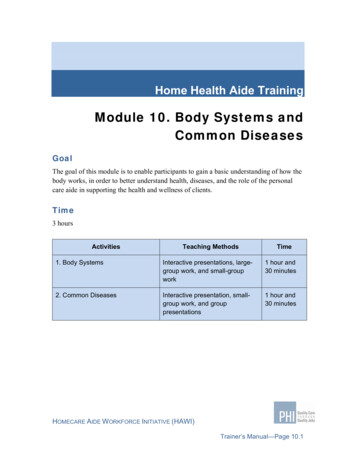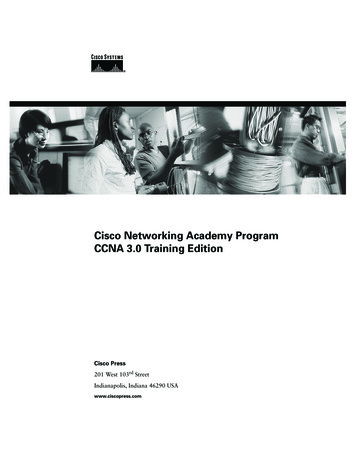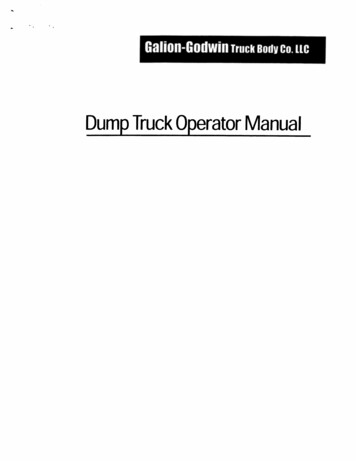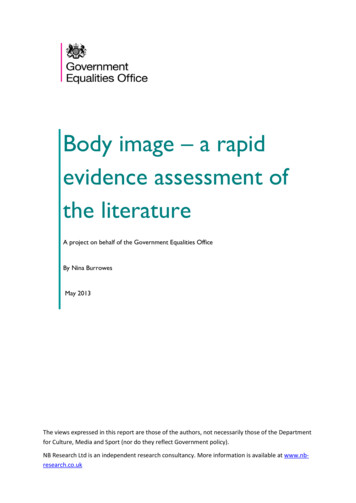
Transcription
Home Health Aide TrainingModule 10. Body Systems andCommon DiseasesGoalThe goal of this module is to enable participants to gain a basic understanding of how thebody works, in order to better understand health, diseases, and the role of the personalcare aide in supporting the health and wellness of clients.Time3 hoursActivitiesTeaching MethodsTime1. Body SystemsInteractive presentations, largegroup work, and small-groupwork1 hour and30 minutes2. Common DiseasesInteractive presentation, smallgroup work, and grouppresentations1 hour and30 minutesHOMECARE AIDE WORKFORCE INITIATIVE (HAWI)Trainer’s Manual—Page 10.1
Module 10. Body Systems and Common DiseasesSupplies Pencils or pensFlip chart, tape, and markers (enough for each group to have one in Activity 2,Option B)Lamination equipment, if availableTeaching Tools, Activity 1. Body System Images (without labels) [seeseparate section “Body System Teaching Tools” after this module]Teaching Tools, Activity 1. Body Systems: Common ProblemsTeaching Tools, Activity 2. How You Can Assist Clients Who HaveCommon DiseasesLearner’s Book1. Introduction to Body Systems2a. The Circulatory System2b. The Digestive System2c. The Endocrine System2d. The Nervous System2e. The Reproductive System2f. The Respiratory System2g. The Skeletomuscular System2h. The Skin2i. The Urinary System3. Helping Clients with Illness4a. Alzheimer’s Disease4b. Arthritis4c. Cancer4d. CVA (Stroke)4e. Diabetes4f. Heart Disease4g. Lung Disease4h. Multiple Sclerosis (MS)4i. Parkinson’s DiseaseHOMECARE AIDE WORKFORCE INITIATIVE (HAWI)Trainer’s Manual—Page 10.2
Module 10. Body Systems and Common DiseasesWorksheets Worksheet 1. Main Parts of the Body SystemsWorksheet 2. Body Systems and What They DoWorksheet 3. Name That Body System!Handouts Handout 1. Body SystemsHandout 2. Common DiseasesAdvance PreparationReview all the training instructions and learner’s materials for this module. Note thaticons are used to remind the trainer of the following:When you are presenting or covering Key Content in the discussion. (KeyContent is also addressed in the Learner’s Book and the handouts, but weuse the “key” icon only when it is covered elsewhere in the learningprocess.)When it is important to ask a particular question to get participants’ input.When it is time to refer to the Learner’s Book.When it is time to distribute a worksheet.When it is time to distribute a handout.Copy all the worksheets and STAPLE them together—one set for each participant.Copy the handouts for participants.Gather all necessary supplies and equipment.Please note that the Key Content is meant to be background information for thetrainer. DO NOT READ OUT LOUD TO PARTICIPANTS.HOMECARE AIDE WORKFORCE INITIATIVE (HAWI)Trainer’s Manual—Page 10.3
Module 10. Body Systems and Common DiseasesActivity 1. Body SystemsMake sure the three worksheets have been stapled together—to make one set for eachparticipant.Prepare the following flip chart pages: “Learning Agenda” (Step 1) “Names of Body Systems” (Step 3)Make one copy of each full-page body system illustration in the Teaching Tools,Activity 1. Body System Images (without labels) [see separate section “BodySystem Teaching Tools” after this module]. [Or, you may laminate these illustrationpages and use the same set for every training.]Make enough copies of the urinary system illustrations, so that each group can haveone page (either male or female) for the demonstration.The Teaching Tools, Activity 1. Body Systems: Common Problems is not meant tobe distributed for this activity. Instead, it is an optional activity for you to use if youhave time left over at the end of Activity 1. (See the Teaching Tip for Step 16.)Activity 2. Common DiseasesPrepare the following flip chart pages: “Disease” (Step 1) [Option A] “Common Diseases Presentations” (Step 5) [Option B] “Group Reports on Common Diseases” (Step 5)Read the descriptions of Option A and Option B carefully, and decide whichapproach you will use.HOMECARE AIDE WORKFORCE INITIATIVE (HAWI)Trainer’s Manual—Page 10.4
Module 10. Body Systems and Common DiseasesActivity 1. Body Systems1 hour and 30 minutesLearning OutcomesBy the end of this activity, participants will be able to:Define “body systems” and describe the types of body parts that make up bodysystems.Identify at least six body systems.Describe the general functions and the main parts of each system.Key Content A body system is a group of body parts that work together to perform a specificfunction or task. All body systems are composed of cells, tissues, membranes, glands, and organs. Body cavities are spaces within the body that are protected by the skeleton and areoccupied by components of the body systems. The major cavities are: cranial, spinal,thoracic, abdominal, and pelvic. Nine body systems are discussed in this module: circulatory, digestive, endocrine,nervous, reproductive, respiratory, skeletomuscular, the skin (integumentary), andurinary. All the body systems are interrelated, and they all slow down as a normalpart of aging. Each system has important functions. Each also has unique problems and diseases. Knowing the basics about how these systems work will help the home health aide tolearn, remember, and carry out his or her role in assisting clients to keep thesesystems healthy and to manage the problems.HOMECARE AIDE WORKFORCE INITIATIVE (HAWI)Trainer’s Manual—Page 10.5
Module 10. Body Systems and Common DiseasesActivity StepsInteractive Presentation—20 minutes1. Introduce the module and learning agenda. Explain that the goal is to helpparticipants develop a basic understanding of the different body systems and howthey work. This will enable them to better understand how to keep the body workingwell, how common diseases affect the body, and how to carry out their role as homehealth aides in maintaining health and coping with disease. Post and review the“Learning Agenda” flip chart page.Flip ChartLEARNING AGENDA:Body Systems and Common Diseases Body systems—what they doand their main parts Common diseases—Whatthey are and how the homehealth aide can assist clients2. Define “body system.” Explain that a body “system” is a group of body parts thatwork together to perform a specific function or task. Note that since everyone has abody, participants all probably have a lot of knowledge about the systems of the body,whether they realize it or not!3. Read the list of body systems. Post and read the flip chart page with the list of bodysystems. Explain that these may sound strange now, but this activity will help themsee that they already know a lot about many of these systems. Note that there areother body systems, but these are the ones they will cover today.Teaching TipDo not describe or explain any of these systems! The main purpose of thislist is to help participants read and pronounce the names of each system.HOMECARE AIDE WORKFORCE INITIATIVE (HAWI)Trainer’s Manual—Page 10.6
Module 10. Body Systems and Common DiseasesFlip ChartNames of Body Systems4. Circulatory system Digestive system Endocrine system Nervous system Reproductive system Respiratory system Skeletomuscular system The skin Urinary systemReview 1. Introduction to Body Systems in the Learner’s Book. Ask if thereare any questions before moving on to the next step.Large-Group Work—10 minutesTeaching TipsThis activity uses small-group work to focus on eight of the nine systemslisted—circulatory, digestive, nervous, reproductive, respiratory,skeletomuscular, the skin, and urinary with the endocrine system beingcovered by an interactive presentation after the group work.5. Introduce this activity. Explain that the purpose of this activity is to introduceparticipants to the body systems, through working in small groups. You willdemonstrate how to do the activity by having them all work on one body systemtogether. After that they will work on the rest of the body systems in their smallgroups.HOMECARE AIDE WORKFORCE INITIATIVE (HAWI)Trainer’s Manual—Page 10.7
Module 10. Body Systems and Common Diseases6.Set up small-group work. Ask participants to close their Learner’s Books andkeep them closed throughout the small-group work. Split participants into groups oftwo or three—with no more than seven groups. Distribute Worksheets 1, 2, and 3 toeach participant. (They should be stapled together.)7. Distribute sample body system image. Give each group one of the body systemimages for the urinary system (either male or female—see Advance Preparation). DONOT TELL THEM WHAT SYSTEM THIS IS! Ask them to note the letter in theheader for this body system image—H1 or H2. Explain that there are two images forthis system, because the main parts look slightly different for men and for women.But every group has the same body system for this demonstration.8.Demonstrate how to do Worksheet 1. Explain that you all will work togetheron Worksheet 1 to figure out which of the “Main Parts” descriptions best matchesthe colored body parts in their picture. Ask participants:Does anyone know what these body parts are called?If someone does know, then you can start reading aloud each answer on Worksheet 1,until you find those body parts. If they do not know, start reading the Main Partsanswers out loud and ask, after each one, if this sounds like the body parts in theirpictures. Once they find the correct answer, ask them all to put the letter H in the boxin front of that answer.Teaching TipWe selected the urinary system for this demonstration because we felt thatparticipants might have a harder time identifying the main parts from thisimage than they would for other body system images. So you may have tohelp them figure out what these parts are. Use clues like asking what bodypart sits low in their bellies and has a tube coming out between their legs(bladder). Also, you can ask what the shape of the two parts higher up in thebody looks like (a bean), and what kind of bean (kidney)? Then ask them tofind those words in the “Main Parts” answers. You may want to write thosewords on a flip chart page, to help them find the words in writing.The correct answer is #4.HOMECARE AIDE WORKFORCE INITIATIVE (HAWI)Trainer’s Manual—Page 10.8
Module 10. Body Systems and Common Diseases9.Demonstrate how to do Worksheet 2. Ask each group to turn to Worksheet2. Now that they have identified the main parts, they need to find the answer for whatthose body parts (and that system) DO for the body. Explain that, like before, thereare two strategies—if they know the answer, then they look for it in Worksheet 2. Ifthey don’t know the answer, then they start reading each one until they find one thatmakes sense. Begin by asking:Does anyone know what the bladder, kidneys, ureters, and urethra do for thebody?If you get some ideas about getting liquids out of the body, tell them that’s right!Then ask them to scan Worksheet 2 for that answer. If they don’t have any idea whatthese body parts do, then start reading and asking after each one if it sounds right.Again, they will put the letter H (for their body system image) in front of the correctanswer.Teaching TipThis time, the correct answer is #12. Hopefully you can give enough clues sothey will recognize this as the right answer and you won’t have to readthrough the whole list.10.Demonstrate how to do Worksheet 3. Ask each participant to turn toWorksheet 3. Now that they have identified the main parts, and what they do for thebody, it’s time to name the body system. Note that some of these systems have VERYlong names, but the names may actually contain clues. Ask:Does anyone think they already know the name of this body system?If they are right, tell them so and ask them to help you find that system on the list inWorksheet 3. If no one has any idea, read through the list out loud until you get to aname that they think makes sense for this body system. As before, they will put theletter H in front of the correct answer.HOMECARE AIDE WORKFORCE INITIATIVE (HAWI)Trainer’s Manual—Page 10.9
Module 10. Body Systems and Common DiseasesTeaching TipIf they don’t know the name of this system, you will read through the wholelist before you get to “Urinary System.”Even if they DO know this answer right away, read through the body systemlist one more time, to reinforce how these words are pronounced. Askparticipants to repeat the body system name after you read it out loud. Thismay be very helpful for participants with lower reading levels.Small-Group Work—35 minutes11. Give instructions. Explain that you want them to repeat this process with seven morebody systems. You will give a body system image to each group now (a different oneto each group). They will have 5 minutes to work together to fill in Worksheets 1, 2,and 3 for their new body system image—just the same way you showed them for theurinary system. After 5 minutes, you will ask them to stop. They will hand in theirbody system image and get a new one. Ask if there are any questions.Teaching TipNote that the endocrine system is not included among the body systemimages. This is because the body parts that are unique to this system are verysmall and obscure, and it is unlikely that students will be able to identify them.The bigger organs (pancreas, ovaries, and testicles) are parts of other bodysystems, and will be identified when reviewing those other systems.The endocrine system will, however, be covered in the interactive presentationthat follows this small-group activity (see step 16).12. Distribute the body system images and ask groups to start. Give a different bodysystem image to each group. Ask them to note the letter at the top of the page—that iswhat they should put next to the right answers on their worksheets.Teaching TipQuickly check on each group, to make sure they understand the instructions.The first two or three body systems may take longer than 5 minutes, but thelater ones will take less time, as they narrow down their options!If you have more than one trainer available, have them also checking on thegroups. It would be good to help the groups to get the first one or two bodyHOMECARE AIDE WORKFORCE INITIATIVE (HAWI)Trainer’s Manual—Page 10.10
Module 10. Body Systems and Common Diseasessystems correct. If not, their wrong answers in the early stages will causeproblems later on, when they become aware that they don’t have the rightanswers remaining on their worksheets.13. Call time and redistribute the body system images. Call time after 5 minutes, butsee if any groups need a couple more minutes to complete at least Worksheets 1 and2. After that, collect the body system image from one group and pass it to another, sothat they all have new body system images to work on. Ask the groups to start ontheir new body systems.Teaching TipKeep checking on the groups, to help them get these first body systemscorrect.With the final two or three body systems, groups may realize that they made amistake on an earlier body system. If that happens, make an announcementthat they should choose the answers that they think are correct for the newbody system—even if they have already chosen that answer for an earliersystem. Reassure them that this will all get worked out in the discussion.With an average of 5 minutes per body system, you will need 35 minutes forseven body systems in this exercise. They will need more than 5 minutes inthe beginning, but less at the end.Interactive Presentation—25 minutes14. Facilitate discussion about the correct answers for each body system. Begin withone of the more obvious body systems—for example, skeletomuscular. Hold up thebody system image and note the letter “A” on the page. Ask one group to volunteertheir answer for the “main parts” for this body system. After you get the correctanswer, ask another group to volunteer their answer for “what it does.” After you getthe correct answer, ask another group to volunteer their answer for the name of thisbody system.Teaching TipIf you hear groans, this means some group(s) did not get the correct answersfor this body system. Note that they should mark the correct body system ontheir worksheets.HOMECARE AIDE WORKFORCE INITIATIVE (HAWI)Trainer’s Manual—Page 10.11
Module 10. Body Systems and Common Diseases15. Continue with the rest of the body systems. Repeat this process with the remainingbody systems. Try to involve every group in sharing their answers. When you aredone, thank the groups for their good efforts on this exercise!Teaching TipIf there are a lot of groups who did not get the correct answers for their bodysystems, stop asking them to share their reports. Instead, give groups a chanceto figure out the correct answers for a new body system image after you show it.16.Review the endocrine system. Tell participants they can now open theirLearner’s Books. Refer to sections 2a to 2i. Note that there is more detail here aboutwhat each body system does and the main parts. Ask participants to turn to section 2c.The Endocrine System; briefly review.Teaching TipIf you have enough time remaining, you can briefly review each section on thebody systems.Another option, if you have time left over, is to review the “CommonProblems” boxes from Teaching Tool, Activity 1. Body Systems: CommonProblems. Without giving the name of the system, you can read the list of“common problems” and ask participants to say which body system they thinkthis would apply to. (These could also be made into cards and given to thesmall groups, for them to guess which body system it applies to.)HOMECARE AIDE WORKFORCE INITIATIVE (HAWI)Trainer’s Manual—Page 10.12
Module 10. Body Systems and Common DiseasesActivity 2. Common Diseases1 hour and 30 minutesLearning OutcomesBy the end of this activity, participants will be able to:List at least five common diseases and describe the signs indicating that someonehas the disease.Describe the role of the home health aide when assisting clients who havecommon diseases, including what to observe, record, and report.Key Content Diseases are conditions that impair or damage the normal function of body systems. The diseases commonly encountered by home health aides include cardiovascular(heart) diseases, cancer, stroke, chronic obstructive pulmonary (lung) disease,diabetes, arthritis, Alzheimer’s disease, multiple sclerosis, and Parkinson’s disease.Knowing some of the basic features of each disease will help the home health aide tolearn, remember, and carry out his or her role in assisting the client to cope with thedisease. The role of the home health aide in regard to diseases, in general, is to: Observe and report changes in physical, emotional, and behavioral status ofthe client. Maintain a safe environment for the client. Assist with activities of daily living, encouraging independence as much aspossible. Provide good nutrition. Use standard (universal) precautions. Provide emotional support to client, as necessary.HOMECARE AIDE WORKFORCE INITIATIVE (HAWI)Trainer’s Manual—Page 10.13
Module 10. Body Systems and Common DiseasesActivity StepsInteractive Presentation—25 minutes1. Lead large-group discussion. Ask participants:What does the word “disease” mean to you?How does a disease hurt the body?After a few responses, post the prepared flip chart page with the definition of“disease.” Point out to participants that they will be better able to understand howdiseases affect the body now that they know how body systems are supposed to work.Flip ChartDISEASEWhen a body system cannotwork the way it is supposed toCommon diseases:2. Brainstorm a list of diseases. Ask participants to name all the diseases they haveheard of. List their responses on the same flip chart page, under the definition.3. Lead large-group discussion. Ask the following questions:Have you ever been around a family member or friend who had one of thesediseases?What kind of assistance did they need?How do you think a home health aide can assist a client who has one ofthese diseases?HOMECARE AIDE WORKFORCE INITIATIVE (HAWI)Trainer’s Manual—Page 10.14
Module 10. Body Systems and Common Diseases4.Review 3. Helping Clients with Illness in the Learner’s Book. After the briefdiscussion in Step 3, section 3 in the Learner’s Book will help participants reinforcewhat they already know or have just learned.Small-Group Work and Presentations—60 minutesOption A: Trainer presents information about eachdisease; participants report “How You Can Assist.”Teaching TipsIn this option, the trainer takes the lead in reviewing the information about thenine diseases (from sections 4a-i in the Learner’s Book). It allows theparticipants to focus more on thinking about how they can assist with one ortwo assigned diseases. If there are enough participants, you can have ninegroups (pairs or triads), with each group assigned to discuss one disease. Withfewer small groups, you can decide to keep each group focused on onedisease, or assign them two diseases to consider “how they can assist.”Option A: Small-Group Work—15 minutes5.Set up small-group work. Split participants into groups of two or three. Assignone of the diseases to each group (or more—see Teaching Tip, above). Post the“Common Diseases Presentation” flip chart page. Explain that you will presentinformation on the first three bullets to the whole class, and they will present whatthey discussed about “how the HHA can assist.” Refer them to sections 4a–i in theLearner’s Book. Explain that they will have 15 minutes to review the section of theLearner’s Book on their disease and prepare notes for their part of the presentation(“How the HHA can assist”).HOMECARE AIDE WORKFORCE INITIATIVE (HAWI)Trainer’s Manual—Page 10.15
Module 10. Body Systems and Common DiseasesFlip ChartCOMMON DISEASESPRESENTATION What is it? Definition ordescription of the disease. Signs that a person has thedisease. What to Observe, Record,and Report How the home health aidecan assist someone who hasthis disease.Option A: Interactive Presentation—45 minutes6. Give a brief presentation about each disease and facilitate small-groupreporting. Review information from the Learner’s Book about each disease,following the first three bullets on the flip chart page. Then ask the small group thatfocused on this disease to share their thoughts about how the HHA can assist. Spendonly five minutes total on each disease.Teaching TipRefer to Teaching Tool, Activity 2. How You Can Assist Clients WhoHave Common Diseases, for essential points. Fill in as needed after thesmall-group report.7. Address remaining diseases. If all nine diseases were NOT assigned to groups,cover all four bullets on the remaining diseases.HOMECARE AIDE WORKFORCE INITIATIVE (HAWI)Trainer’s Manual—Page 10.16
Module 10. Body Systems and Common DiseasesOption B: Participants present all information aboutassigned diseases, including “How You Can Assist.”Teaching TipsThis option allows participants to learn more about one assigned disease andto share their learning with their peers. The activity is designed for six smallgroups, to focus on six diseases arthritis, cancer, diabetes, heart disease,lung disease, and stroke. (Alzheimer’s disease will be covered in detail inanother module. Multiple sclerosis and Parkinson’s disease can be covered bythe trainer in Step 7, following the group presentations.)With a larger class, you may want to include all nine diseases in this activity,forming more than six small groups and allowing more time for groupreports—about 5 minutes per disease. With a smaller class, you may want tohave fewer than six groups, and assign more than one disease to each groupand/or have the trainer cover more diseases during the interactive presentationafter the group reports.Option B: Small-Group Work—20 minutes5)Set up small-group work. Split participants into six groups. Distribute flipchart paper and markers to each group. Assign one of the diseases to each group. Postand review the “Group Reports on Common Diseases” flip chart page with topics forthem to cover. Explain that they have 20 minutes to prepare a flip chart page with thesummary information about their disease to present as a group. Refer to sections 3a–iin the Learner’s Book and note that the information needed can be found there. Aswith Activity 1. Body Systems, you (or another trainer) will be sitting at the “helpdesk” to answer questions.HOMECARE AIDE WORKFORCE INITIATIVE (HAWI)Trainer’s Manual—Page 10.17
Module 10. Body Systems and Common DiseasesFlip ChartGROUP REPORTS ON COMMONDISEASES What is it? Definition ordescription of the disease. Signs that a person has thedisease. What to Observe, Record,and Report How the home health aidecan assist someone who hasthis disease.Option B: Small-Group Reporting—40 minutes6) Facilitate reporting back to the large group. Ask each small group to take 5minutes to post their flip chart page and present their disease. Thank each group andcorrect misinformation as necessary.Teaching TipBasic information about how the HHA can help is provided in TeachingTools, Activity 2. How You Can Assist Clients Who Have CommonDiseases.7) Address remaining diseases. After all the group presentations are completed, presentthe information about any diseases that were not covered.HOMECARE AIDE WORKFORCE INITIATIVE (HAWI)Trainer’s Manual—Page 10.18
Module 10. Body Systems and Common DiseasesBoth Options A & B: Interactive Presentation—5 minutes8. Review ways the HHA can assist sick clients. Refer to“How You Can Assist” fromsection 3. Helping Clients with Illness in the Learner’s Book. Ask:How can you use what you have learned today to help you to carry out thisrole?9.Summarize the module. Distribute and review Handout 1. Body Systems andHandout 2. Common Diseases. Ask participants if they have any questions.HOMECARE AIDE WORKFORCE INITIATIVE (HAWI)Trainer’s Manual—Page 10.19
Module 10. Body Systems and Common DiseasesTEACHING TOOLS, Activity 1Body System Images (without labels) Skeletomuscular (p. 22) Respiratory (p. 23) Nervous (p. 24) Circulatory (p. 25) Digestive (p. 26) The Skin (p. 27) Female Reproductive System (p. 28) Male Reproductive System (p. 29) Female Urinary System (p. 30) Male Urinary System (p. 31)HOMECARE AIDE WORKFORCE INITIATIVE (HAWI)Trainer’s Manual—Page 10.20
Body System AHOMECARE AIDE WORKFORCE INITIATIVE (HAWI)Trainer’s Manual—Page 10.21
Body System BHOMECARE AIDE WORKFORCE INITIATIVE (HAWI)Trainer’s Manual—Page 10.22
Body System CHOMECARE AIDE WORKFORCE INITIATIVE (HAWI)Trainer’s Manual—Page 10.23
Body System DHOMECARE AIDE WORKFORCE INITIATIVE (HAWI)Trainer’s Manual—Page 10.24
Body System EHOMECARE AIDE WORKFORCE INITIATIVE (HAWI)Trainer’s Manual—Page 10.25
Body System FHOMECARE AIDE WORKFORCE INITIATIVE (HAWI)Trainer’s Manual—Page 10.26
Body System G1HOMECARE AIDE WORKFORCE INITIATIVE (HAWI)Trainer’s Manual—Page 10.27
Body System G2HOMECARE AIDE WORKFORCE INITIATIVE (HAWI)Trainer’s Manual—Page 10.28
Body System H1HOMECARE AIDE WORKFORCE INITIATIVE (HAWI)Trainer’s Manual—Page 10.29
Body System H2HOMECARE AIDE WORKFORCE INITIATIVE (HAWI)Trainer’s Manual—Page 10.30
Module 10. Body Systems and Common DiseasesTEACHING TOOLS, Activity 1Body Systems: Common ProblemsPage 1 of 4Instructions: This information is meant to be used by the trainer. If there is time left atthe end of Activity 1, each box can be read out loud, for participants to guess which bodysystem they apply to.Common Problems of the Circulatory SystemA client may: Feel very weak Have a heartbeat that is too fast, too slow, oruneven Have arteries clogged with fat (atherosclerosis) orwith bits of minerals (arteriosclerosis) Have blood pressure that is too high or too low.Blood pressure is the force of blood against arterywalls.Common Problems of the Digestive System Constipation is hard stools.Diarrhea is loose stools.Nausea or vomitingHeartburn happens when stomach acid goes intothe throat.Hemorrhoids are swollen veins at the end of thelarge intestine. They cause itching of the anus.Stomach pain can happen for a number of reasons.HOMECARE AIDE WORKFORCE INITIATIVE (HAWI)Trainer’s Manual—Page 10.31
Module 10. Body Systems and Common DiseasesTEACHING TOOLS, Activity 1Body Systems: Common ProblemsPage 2 of 4Common Problems of the Endocrine SystemA client may: Feel very tired Gain or lose weight Heal more slowly than usualCommon Problems of the Nervous SystemA client may have: A prickly feeling Headaches or other pain Trouble controlling their bowel or bladder Trouble seeing, hearing, touching, tasting, orsmelling. Trouble thinkingCommon Problems of the Reproductive SystemA client may have: Enlarged prostate glandFluid that comes out of the penis or vaginaMenstrual problemsProblems with sexRed, swollen vagina or labiaSwollen testiclesHOMECARE AIDE WORKFORCE INITIATIVE (HAWI)Trainer’s Manual—Page 10.32
Module 10. Body Systems and Common DiseasesTEACHING TOOLS, Activity 1Body Systems: Common ProblemsPage 3 of 4Common Problems of the Respiratory SystemA client may: Cough Have a runny nose Have trouble breathing Make a whistling sound when they breatheCommon Problems of the Skeletomuscular SystemA client may: Sprain a joint or ligament Strain a muscle Have joint or muscle pain Have decreased range of motion Have a contracture. That's when flexing musclesget short. This makes it hard to move. There is nocure. Break a boneHOMECARE AIDE WORKFORCE INITIATIVE (HAWI)Trainer’s Manual—Page 10.33
Module 10. Body Systems and Common DiseasesTEACHING TOOLS, Activity 1Body Systems: Common ProblemsPage 4 of 4Common Skin ProblemsA client may have: Dry skin Cuts and bruises Rashes, blisters, warts, or boils Thinning and falling out hair Itchy scalp or skin SoresCommon Problems of the Urinary SystemA client may have: Trouble controlling their bladder Painful urination Dry mouth Dry skin No tears Change in color, smell, or cons
Trainer's Manual—Page 10.1 Home Health Aide Training Module 10. Body Systems and Common Diseases Goal The goal of this module is to enable participants to gain a basic understanding of how the body works, in order to better understand health, diseases, and the role of the personal care aide in supporting the health and wellness of clients.










